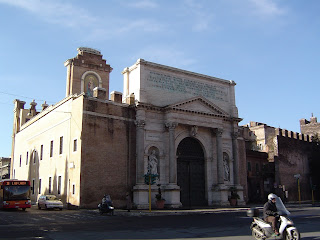Anarchist tried to kill Mussolini with grenade
 |
| Gino Lucetti was part of a substantial anarchist presence in Carrara |
Gino Lucetti, who acquired notoriety for attempting to
assassinate Italy’s Fascist dictator Benito Mussolini in Rome in 1926, was born
on this day in 1900.
A lifelong anarchist, part of a collective of like-minded
young men and women from Carrara in Tuscany, he planned to kill Mussolini on
the basis that doing so would save the lives of thousands of potential future
victims of the Fascist regime.
Lucetti hatched his plot while in exile in France, where he
had fled after taking a Fascist bullet in the neck following an argument in a
bar in Milan, clandestinely returning several times to Carrara to finalise the
details.
After enlisting the help of other anarchists, notably
Steffano Vatteroni, who worked as a tinsmith in Rome, and Leandro Sorio, a
waiter originally from Brescia, he returned to Rome to carry out the attack.
Vatteroni was able to obtain information about Mussolini’s
movements from a clerical worker in the dictator’s Rome offices, including
details of his regular motorcades through the city. These were carefully choreographed
affairs in which cheering citizens lined the streets, enabling Mussolini to
present an image to the world of a popular leader.
Sorio provided a penniless Lucetti with somewhere to stay in
Rome while he planned the attack.
 |
| Mussolini would ride in an open-topped car, milking the applause of the crowds |
Lucetti settled on September 11 as the day he would kill Il
Duce. He had observed how closely his famous Lancia car passed by the crowds
and having obtained advance notice that Mussolini’s route that day would pass
through the historic gateway at Porta Pia, he loitered in wait for several
hours.
When the Lancia came into view, he stepped forward from the
crowd and hurled one of two grenades he had in the pockets of his jacket in the
direction of the car, hoping to land it at the feet of the dictator as he waved
to the cheering masses.
Instead it hit the windscreen, shattering the glass but
failing to explode, then bouncing off the running board and into the road. It blew up after Mussolini’s car had gone by,
the force of the blast somewhat ironically knocking Lucetti off his feet.
In the confusion that followed, Lucetti initially sheltered
in a doorway in nearby Via Nomentana, but it was not long before Mussolini’s bodyguards
found him.
He was beaten up on the spot, then subjected to a violent
interrogation at police headquarters.
He compounded his actions by giving police a false identity,
insisting he was Ermete Giovanni, from Castelnuovo Garfagnana in Tuscany, as a
result of which the town near Lucca was blockaded and dozens of people arrested.
Lucetti may have failed in his assassination attempt but regarded showing up
the incompetence of the police as at least a small consolation.
 |
| Lucetti's grave in Carrara, bedecked in an anarchist flag |
He stood trial in 1927, at the end of which he was sentenced
to 30 years in jail. Vatteroni and Sorio received sentences of around 20 years.
Lucetti spent 17 years in a prison on Santo Stefano, one of
the Pontine islands off the coast between Rome and Naples.
He died on the island of Ischia, in the Bay of Naples, in
September, 1943, in circumstances that are not clear. Some accounts say he escaped from Santo
Stefano, others that he was transferred to Ischia.
Either way, he was killed during shelling of the island,
either by American forces, or by German positions on neighbouring Procida.
Lucetti’s body was returned to Carrara, where he is buried alongside
other anarchists, including Goliardo Fiaschi, who was a prominent figure in the
Italian resistance in the Second World War, and the Giuseppe Pinelli,
who fell from a fourth-floor window of the Milan police headquarters after
being taken in for questioning about the Piazza Fontana bombing in 1969, and
was later immortalised in Dario Fo’s play, Accidental Death of an Anarchist.
 |
| The Michelangelo-designed gate at Porta Pia |
Travel tip:
Porta Pia is a gateway in Rome’s ancient Aurelian Walls,
designed by Michelangelo and the artist’s final architectural project before
his death in 1564. It acquired a special place in Italian history as a result of
a section of wall immediately adjoining it being breached in September 1870, enabling
forces led by Piedmontese General Raffaele Cadorno to storm the city, overwhelming
what remained of the Papal garrisons and completing the unification of the
country.
 |
| The mountains around Carrara sometimes appear to be covered in snow even in summer |
Travel tip:
Carrara, famous for its blue and white marble, sits in a valley
that descends from the Apuane Alps in Tuscany, in which the natural white of
the peaks often convinces visitors they are covered with snow even in the
summer. Marble has been quarried in the area for more than 2,000 years. Michelangelo
was said to have been so taken with the purity of the stone that he spent eight
months there choosing blocks for specific projects. Nowadays, Carrara is a city of almost 70,000
inhabitants. It became a hotbed of
anarchists in the last 19th and early 20th century,
largely because of the radical views of the quarry workers.